Fretting-Fatigue Analysis of Shot-Peened Al 7075-T651 Test Specimens
Abstract
1. Introduction
2. Experiment Setup
3. Results
3.1. Fatigue Lives
3.1.1. Shot-Peening Improvement of Fatigue Life
3.1.2. Polished Surface
3.2. Fracture Surfaces
3.3. Scar of Contact Zone
4. Cyclic Relaxation of Residual Stress
5. Conclusions
Author Contributions
Funding
Acknowledgments
Conflicts of Interest
References and Notes
- Waterhouse, R.; Lindley, T. Fretting Fatigue; ESIS Publication 18: London, UK, 1994. [Google Scholar]
- Hoeppner, D.W.; Chandrasekaran, V. Fretting Fatigue: Current Technology and Practices; Elliot, C.B., Ed.; ASTM STP 1367: Philadelphia, PA, USA, 2000. [Google Scholar]
- Domínguez, J. Cyclic variations in friction forces and contact stresses during fretting fatigue. Wear 1998, 218, 43–53. [Google Scholar] [CrossRef]
- Madge, J.J.; Leen, S.B. The critical role of fretting wear in the analysis of fretting fatigue. Wear 2007, 263, 542–551. [Google Scholar] [CrossRef]
- Magaziner, R.; Jin, O. Slip regime explanation of observed size effects in fretting. Wear 2004, 257, 190–197. [Google Scholar] [CrossRef]
- Cardoso, R.A.; Doca, T.; Néron, D.; Pommier, S.; Araújo, J.A. Wear numerical assessment for partial slip fretting fatigue conditions. Trib. Int. 2019, 136, 508–523. [Google Scholar] [CrossRef]
- Golden, P.J.; Hutson, A.; Sundaramc, V.; Arpsd, J.H. Effect of surface treatments on fretting fatigue of Ti–6Al–4V. Int. J. Fat. 2007, 29, 1302–1310. [Google Scholar] [CrossRef]
- Hutson, A.L.; Niinomi, M. Effect of various surface conditions on fretting fatigue behaviour of Ti–6Al–4V. Int. J. Fat. 2002, 24, 1223–1234. [Google Scholar] [CrossRef]
- Fu, Y.; Wei, J. Some considerations on the mitigation of fretting damage by the application of surface-modification technologies. J. Mat. Proc. Technol. 2000, 99, 231–245. [Google Scholar] [CrossRef]
- Navarro, C.; Muñoz, S.; Domínguez, J. Fracture mechanics approach to fretting fatigue behaviour of coated aluminium alloy components. J. Strain Anal. Eng. Des. 2014, 49, 66–75. [Google Scholar] [CrossRef]
- Ganesh Sundara Raman, S.; Jayaprakash, M. Influence of plasma nitriding on plain fatigue and fretting fatigue behaviour of AISI 304 austenitic stainless steel. Surf. Coat. Technol. 2007, 201, 5906–5911. [Google Scholar] [CrossRef]
- Golden, P.J.; Michael, J. Life prediction of fretting fatigue with advanced surface treatments. Mater. Sci. Eng. A 2007, 468–470, 15–22. [Google Scholar]
- Prevéy, P.S.; Jayaraman, N. Mitigation of fretting fatigue damage in blade and disk pressure faces with low plasticity burnishing. J. Eng. Gas Turbines Power 2010, 132, 61–69. [Google Scholar] [CrossRef]
- Srinivasan, S.; Garcia, D.B. Fretting fatigue of laser shock peened Ti–6Al–4V. Tribol. Int. 2009, 42, 1324–1329. [Google Scholar] [CrossRef]
- Liu, K.K.; Michael, R. The effects of laser peening and shot peening on fretting fatigue in Ti–6Al–4V coupons. Tribol. Int. 2009, 42, 1250–1262. [Google Scholar] [CrossRef]
- Vázquez, J.; Navarro, C.; Domínguez, J. Experimental Results in Fretting Fatigue with Shot and Laser Peened Al 7075-T651 Specimens. Int. J. Fat. 2012, 40, 143–153. [Google Scholar] [CrossRef]
- Vázquez, J.; Navarro, C.; Domínguez, J. A model to predict fretting fatigue life including residual stresses. Theor. Appl. Fract. Mech. 2014, 73, 144–151. [Google Scholar] [CrossRef]
- Zhang, X.; Liu, D. Effect of shot peening on fretting fatigue of Ti811 alloy at elevated temperature. Int. J. Fat. 2009, 31, 889–893. [Google Scholar] [CrossRef]
- Yang, Q.; Zhou, W. Effect of shot-peening on the fretting wear and crack initiation behavior of Ti-6Al-4V dovetail joint specimens. Int. J. Fat. 2018, 107, 83–95. [Google Scholar] [CrossRef]
- Majzoobi, G.H.; Abbasi, F. On the effect of shot-peening on fretting fatigue of Al7075-T6 under cyclic normal contact loading. Surf. Coat. Tech. 2017, 328, 292–303. [Google Scholar] [CrossRef]
- Vázquez, J.; Navarro, C.; Domínguez, J. Analysis of the effect of a textured surface on fretting fatigue. Wear 2013, 305, 23–35. [Google Scholar] [CrossRef]
- Benedetti, M.; Fontanari, V.; Monelli, B.D. Plain fatigue resistance of shot peened high strength aluminium alloys: Effect of loading ratio. Procedia Eng. 2010, 2, 397–406. [Google Scholar] [CrossRef]
- Takahashi, K.; Osedo, H.; Suzuki, T.; Fukuda, S. Fatigue strength improvement of an aluminum alloy with a crack-like surface defect using shot peening and cavitation peening. Eng. Fract. Mech. 2018, 193, 151–161. [Google Scholar] [CrossRef]
- Benedetti, M.; Fontanari, V.; Santus, C.; Bandini, M. Notch fatigue behaviour of shot peened high-strength aluminium alloys: Experiments and predictions using a critical distance method. Int. J. Fatigue 2010, 32, 1600–1611. [Google Scholar] [CrossRef]
- Honda, T.; Ramulu, M.; Kobayashi, A.S. Effect of Shot Peening on Fatigue Crack Growth in 7075-T7351. In Residual Stress Effects on Fatigue and Fracture Testing and Incorporation of Results into Design; ASTM International: West Conshohocken, PA, USA, 2009; pp. 14–33. [Google Scholar]
- Liu, X.; Liu, J.; Zuo, Z.; Zhang, H. Effects of Shot Peening on Fretting Fatigue Crack Initiation Behavior. Materials 2019, 12, 743. [Google Scholar] [CrossRef]
- Majzoobi, G.H.; Azadikhah, K.; Nemati, J. The effects of deep rolling and shot peening on fretting fatigue resistance of Aluminum-7075-T6. Mater. Sci. Eng. A 2009, 516, 235–247. [Google Scholar] [CrossRef]
- Wittkowsky, B.U.; Birch, P.R.; Dominguez, J.; Suresh, S. An Apparatus for Quantitative Fretting Fatigue Testing. Fatigue Fract. Eng. Mater. Struct. 1999, 22, 307–320. [Google Scholar] [CrossRef]
- Merati, A.; Eastaugh, G. Determination of fatigue related discontinuity state of 7000 series of aerospace aluminium alloys. Eng. Fail. Anal. 2007, 14, 673–685. [Google Scholar] [CrossRef]
- Czerwinski, F. Controlling the ignition and flammability of magnesium for aerospace applications. Corros. Sci. 2014, 86, 1–16. [Google Scholar] [CrossRef]
- Alloy 7075 Plate and Sheet: Alcoa Mill Products: SPD-10-037, 2001.
- Boller, C.; Seeger, T. Materials data for Cyclic Loading, 1st ed.; Elsevier: Amsterdam, The Netherlands, 1998. [Google Scholar]
- Tur, M.; Fuenmayor, J.; Ródenas, J.J.; Giner, E. 3D analysis of the influence of specimen dimensions on fretting stresses. Finite Elem. Anal. Des. 2003, 39, 933–949. [Google Scholar] [CrossRef]
- Vázquez, J.; Navarro, C.; Domínguez, J. A new method for obtaining the stress field in plane contacts. Int. J. Solids. Struct. 2012, 49, 3659–3665. [Google Scholar] [CrossRef]
- Vázquez, J.; Navarro, C.; Domínguez, J. Explicit equations for sub-surface stress field in plane contacts. Int. J. Mech. Sci. 2013, 67, 53–58. [Google Scholar] [CrossRef]
- AMS2430: Shot peening, automatic. SAE Standards: AMS B Finishes Processes and Fluids Committee, 2009.
- Watanabe, Y.; Hasegawa, N.; Endo, H.; Marui, E.; Aoki, Y. An effect of shot peening on fretting fatigue. In Proceedings of the ICSP-7, Warsaw, Poland, 28–30 September 1999; pp. 127–134. [Google Scholar]
- Waterhouse, R.B.; Trowsdale, A.J. Residual stress and surface roughness in fretting fatigue. J. Phys. D 1992, 25, A236–A237. [Google Scholar] [CrossRef]
- Schajer, G.S. Measurement of Non-Uniform Residual Stresses Using the Hole Drilling Method, Part I—Stress Calculation Procedures. ASME J. Eng. Mater. Technol. 1988, 110, 318–342. [Google Scholar] [CrossRef]
- Schajer, G.S. Measurement of Non-Uniform Residual Stresses Using the Hole Drilling Method, Part II—Practical Application of the Integral Method. ASME J. Eng. Mater. Technol. 1988, 110, 344–349. [Google Scholar] [CrossRef]
- EN 15305:2008. Non-destructive Testing–Test Method for Residual Stress analysis by X-ray. Diffraction. Available online: https://shop.bsigroup.com/ProductDetail/?pid=000000000030199156 (accessed on 20 April 2019).
- Moore, M.G.; Evans, W.P. Mathematical correction for stress in removed layers in X-ray diffraction residual stress analysis. SAE Trans. 1958, 66, 340–345. [Google Scholar]
- Tsui, T.Y.; Oliver, W.; Pharr, G.M. Influences of stress on the measurement of mechanical properties using nanoindentation: Part I: Experimental studies in an aluminium alloy. J. Mater. Res. 1996, 11, 752–759. [Google Scholar] [CrossRef]
- Navarro, C.; Muñoz, S.; Domínguez, J. On the use of multiaxial fatigue criteria for fretting fatigue life assessment. Int. J. Fat. 2008, 30, 32–44. [Google Scholar] [CrossRef]
- Abood, A.N.; Saleh, A.H.; Salem, R.K.; Kadhim, G.A.; Abdullah, Z.W. Strain Life of Shot Peening AA 2024-T4. J. Mater. Sci. Res. 2012, 2, 113–123. [Google Scholar] [CrossRef]
- Dalaei, K.; Karlsson, B.; Svensson, L.-E. Stability of shot peening induced residual stresses and their influence on fatigue lifetime. Mater. Sci. Eng. A 2011, 528, 1008–1015. [Google Scholar] [CrossRef]
- Deng, Y.; Zhang, B.; Luo, W. The fretting behaviour of a nitrided steel 38CrMoAl. Wear 1988, 125, 193–204. [Google Scholar]
- Li, C.X.; Sun, Y.; Bell, T. Consideration of fretting fatigue properties of plasma nitrided En19 steel. Surf. Eng. 1999, 15, 149–153. [Google Scholar]
- Mubarak Ali, M.; Ganesh Sundara Raman, S. Effect of Plasma Nitriding Environment and Time on Plain Fatigue and Fretting Fatigue Behavior of Ti–6Al–4V. Tribol. Lett. 2010, 38, 291. [Google Scholar] [CrossRef]
- Mutoh, Y.; Tanaka, K. Fretting fatigue in several steels and a cast iron. Wear 1988, 125, 175–191. [Google Scholar] [CrossRef]
- Navarro, C.; Vázquez, J.; Domínguez, J. A general model to estimate life in notches and fretting fatigue. Eng. Fract. Mech. 2011, 78, 1590–1601. [Google Scholar] [CrossRef]
- Kodama, S. The behavior of residual stress during fatigue stress cycles. In Proceedings of the International Conference on Mechanical Behavior of Metals II, Kyoto, Japan, 15–20 August 1971; 1972; pp. 111–118. [Google Scholar]
- Zhuang, W.Z.; Halford, G.R. Investigation of residual stress relaxation under cyclic load. Int. J. Fat. 2001, 23, 31–37. [Google Scholar] [CrossRef]
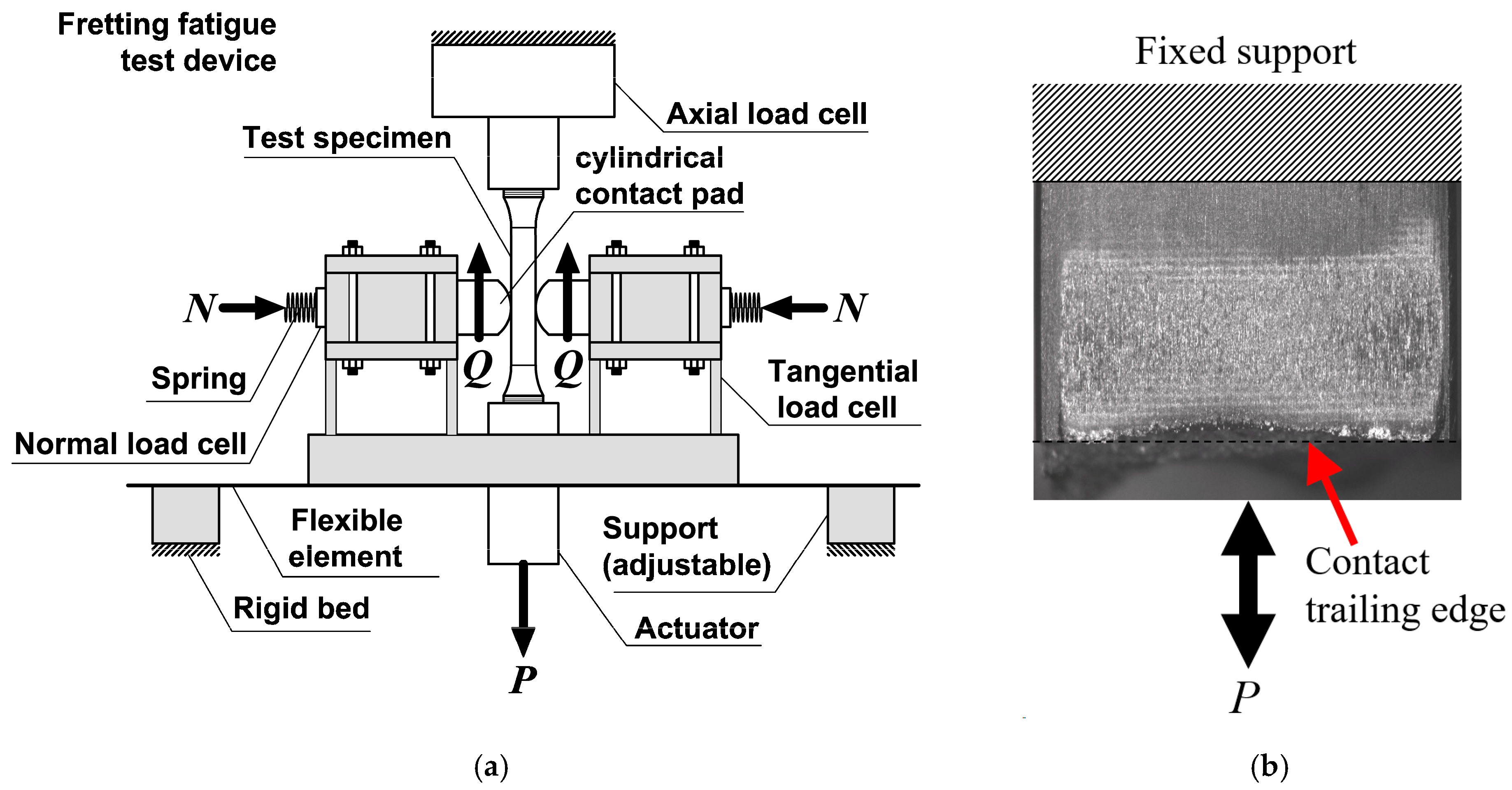

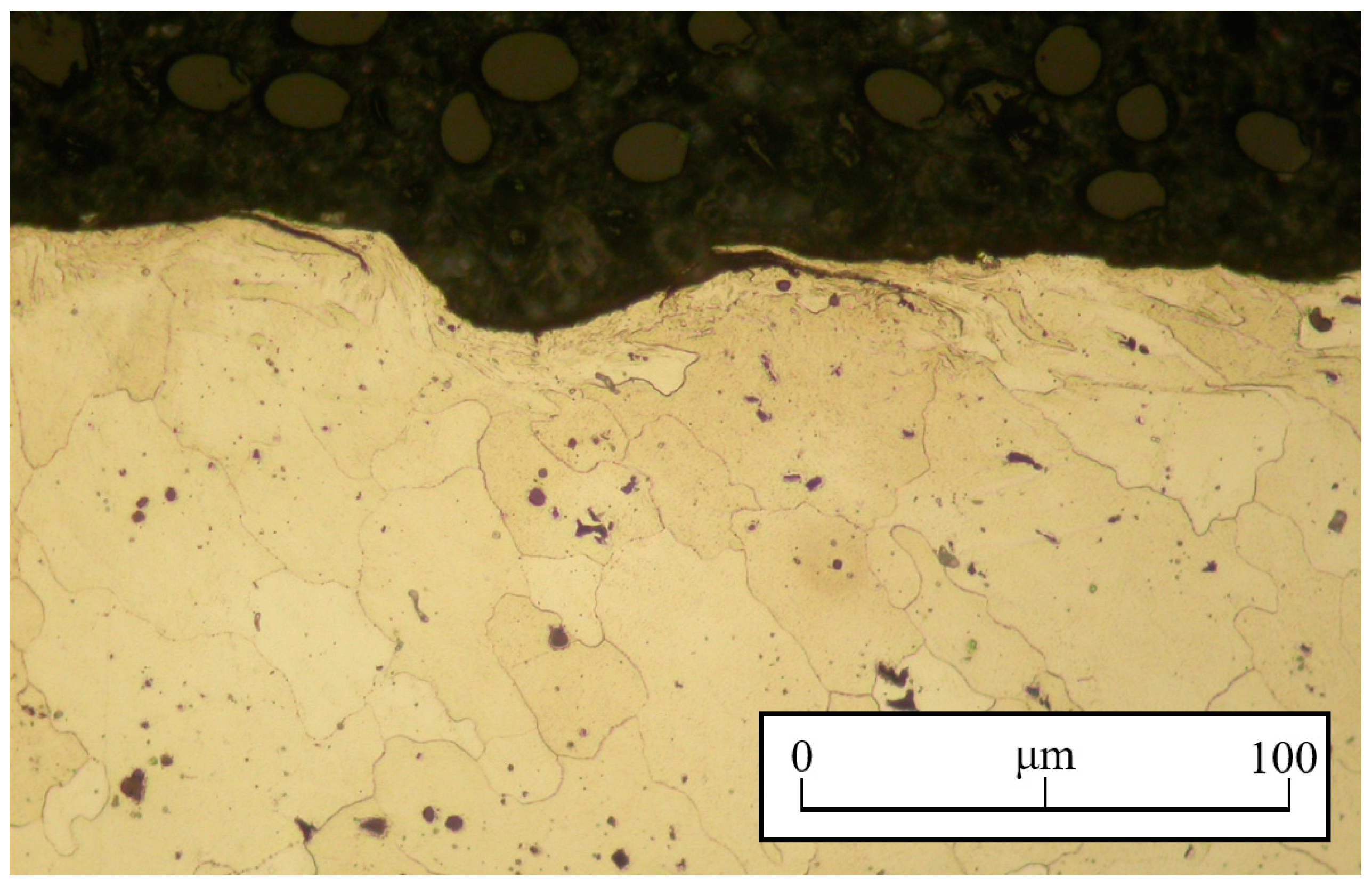
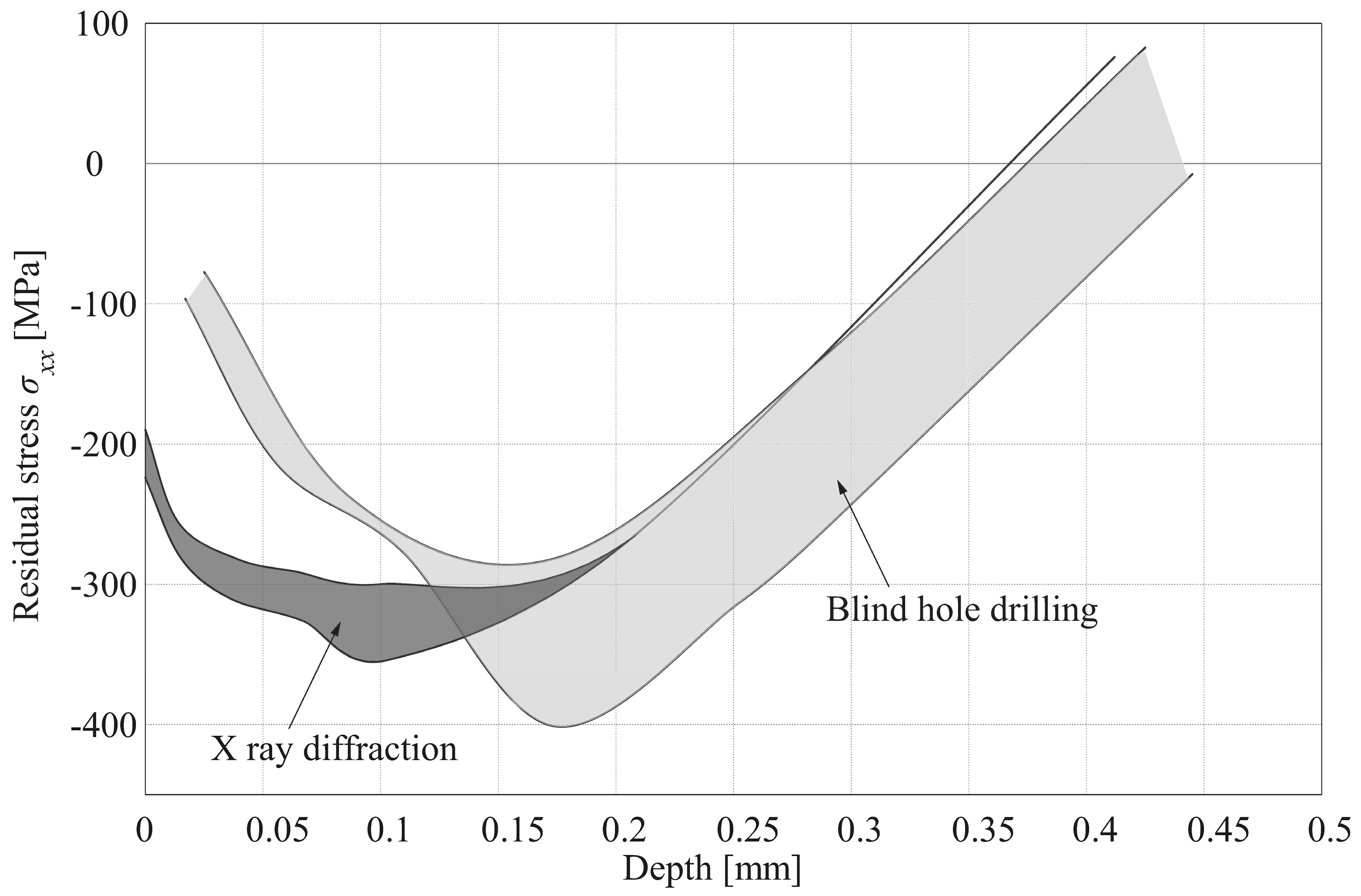
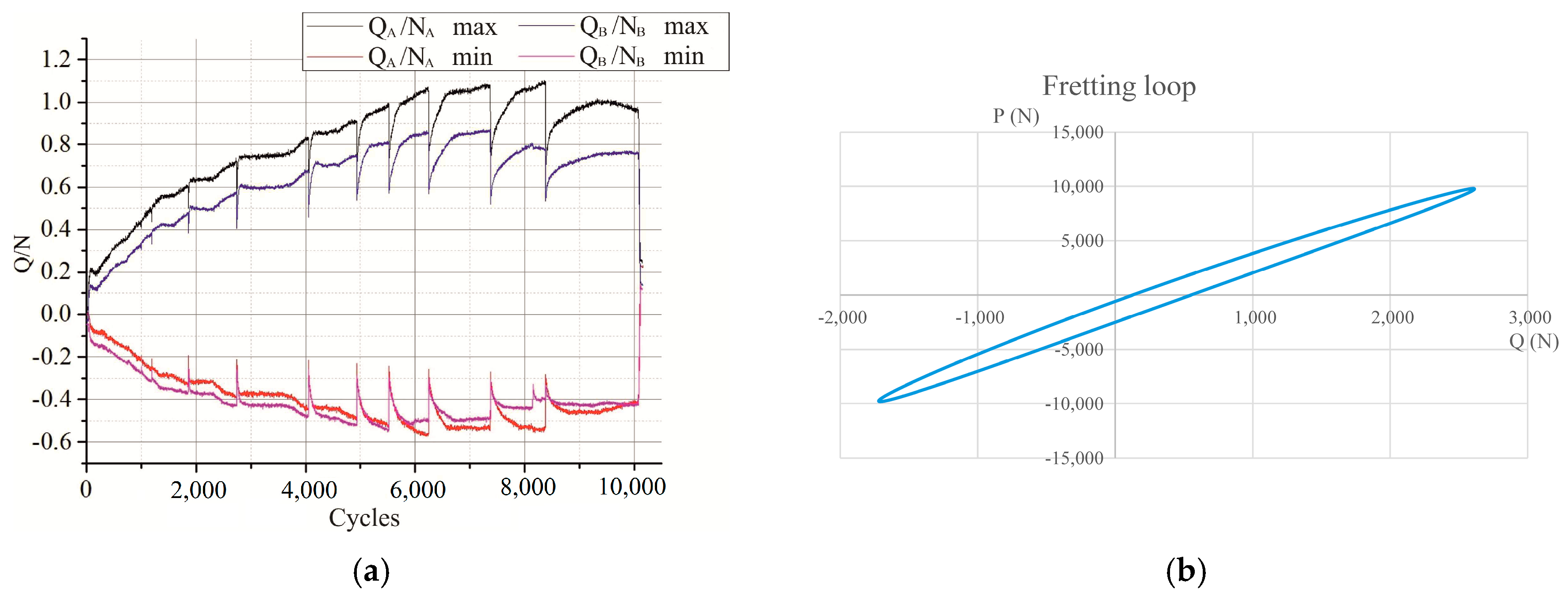
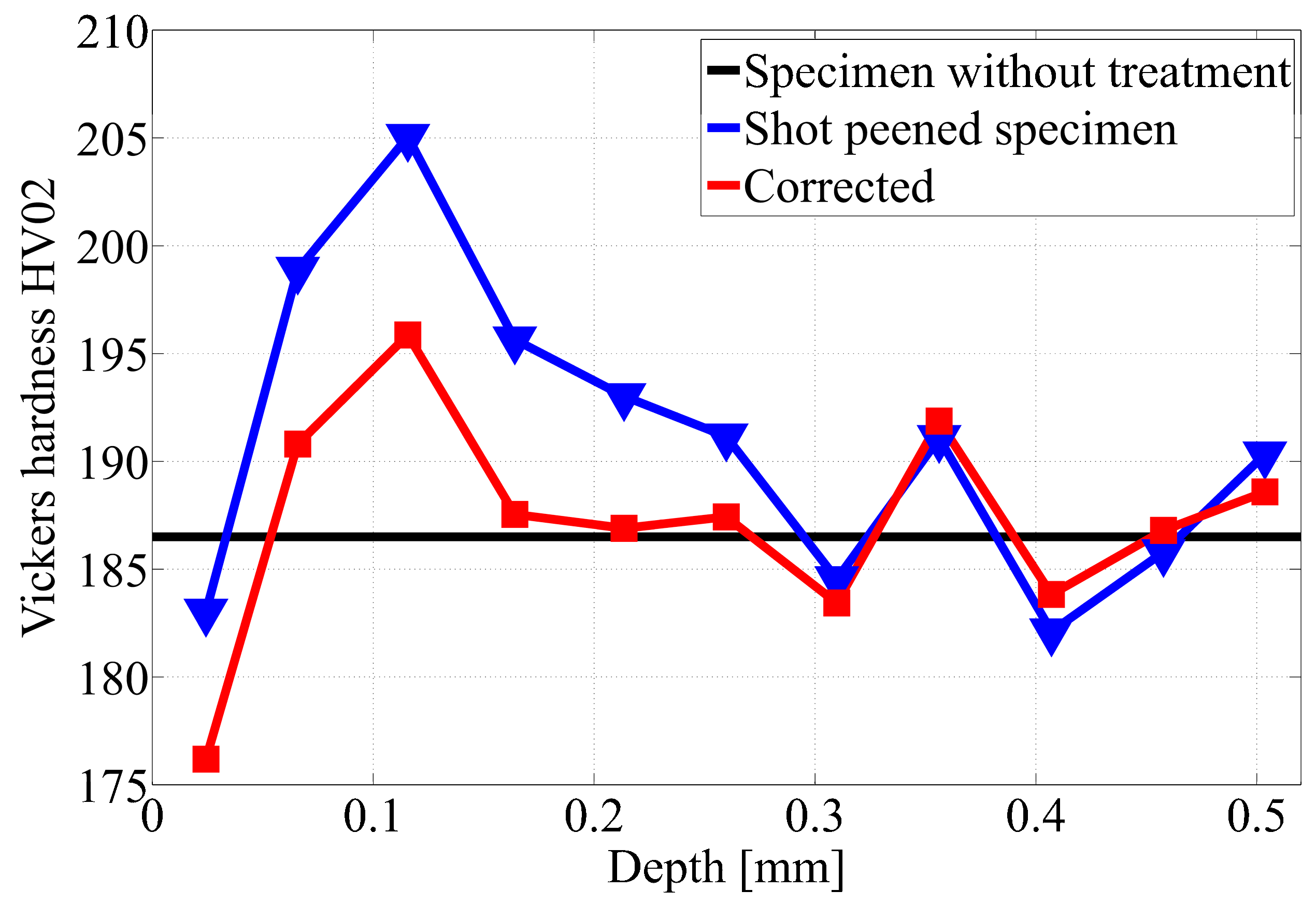
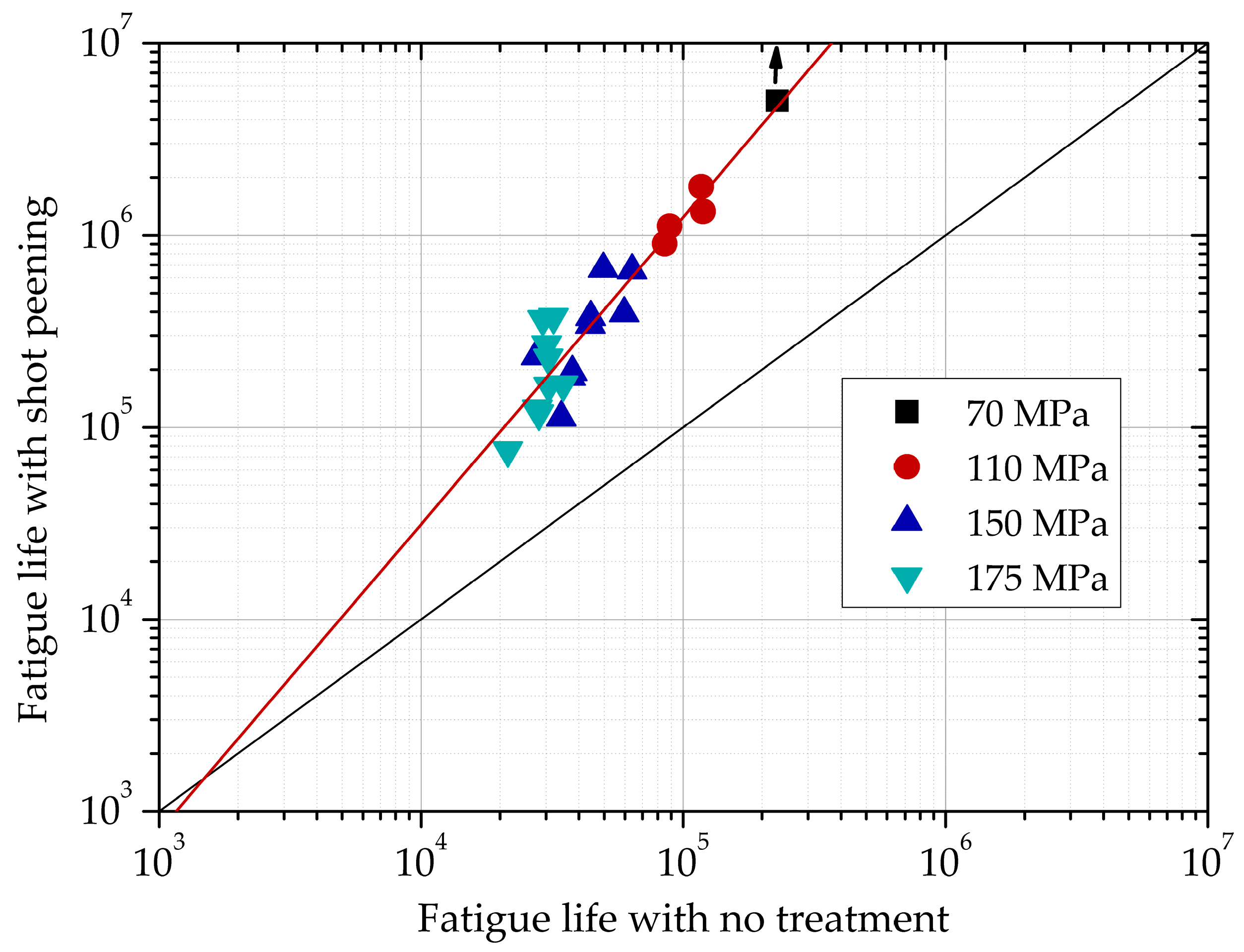
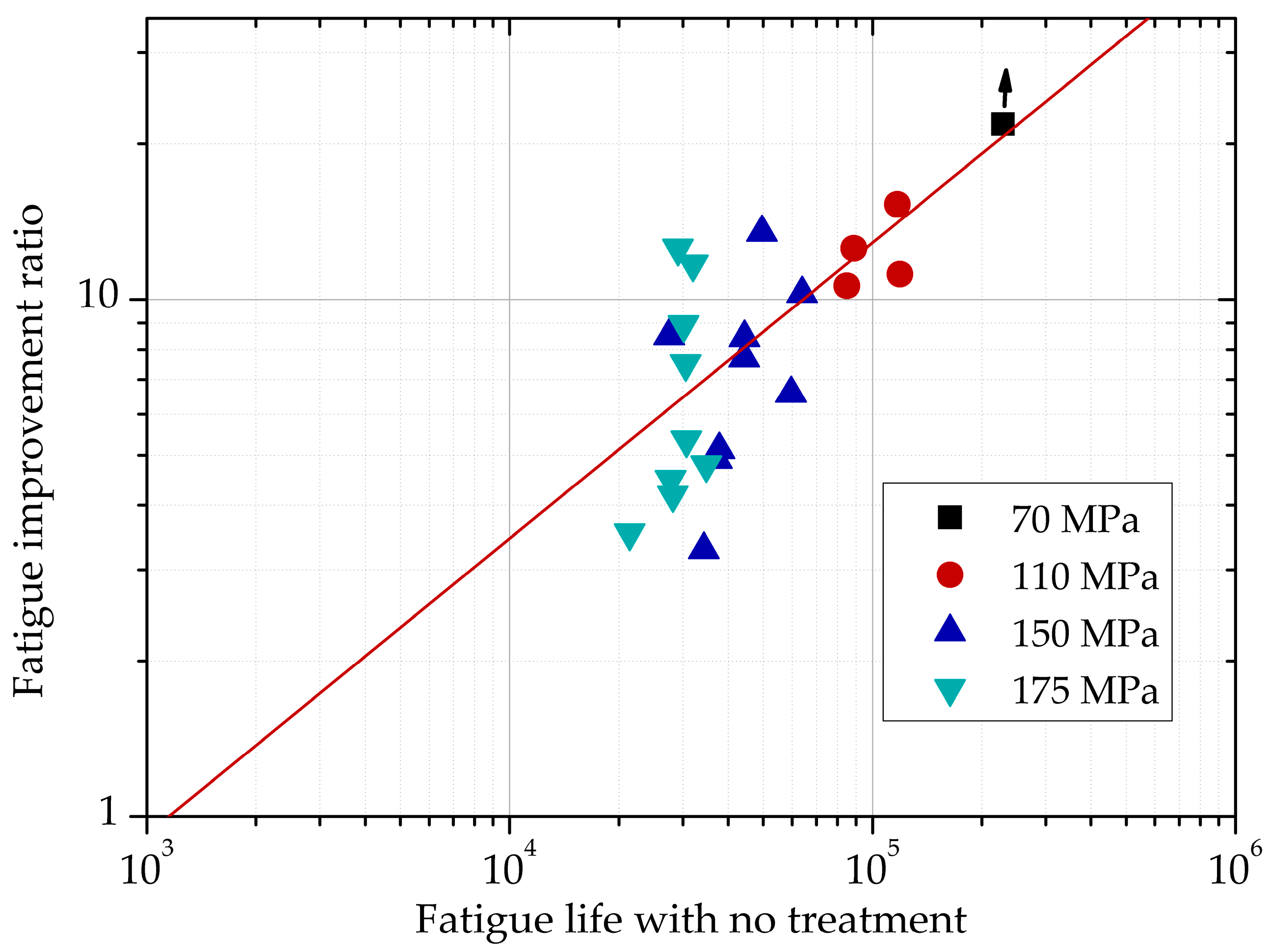
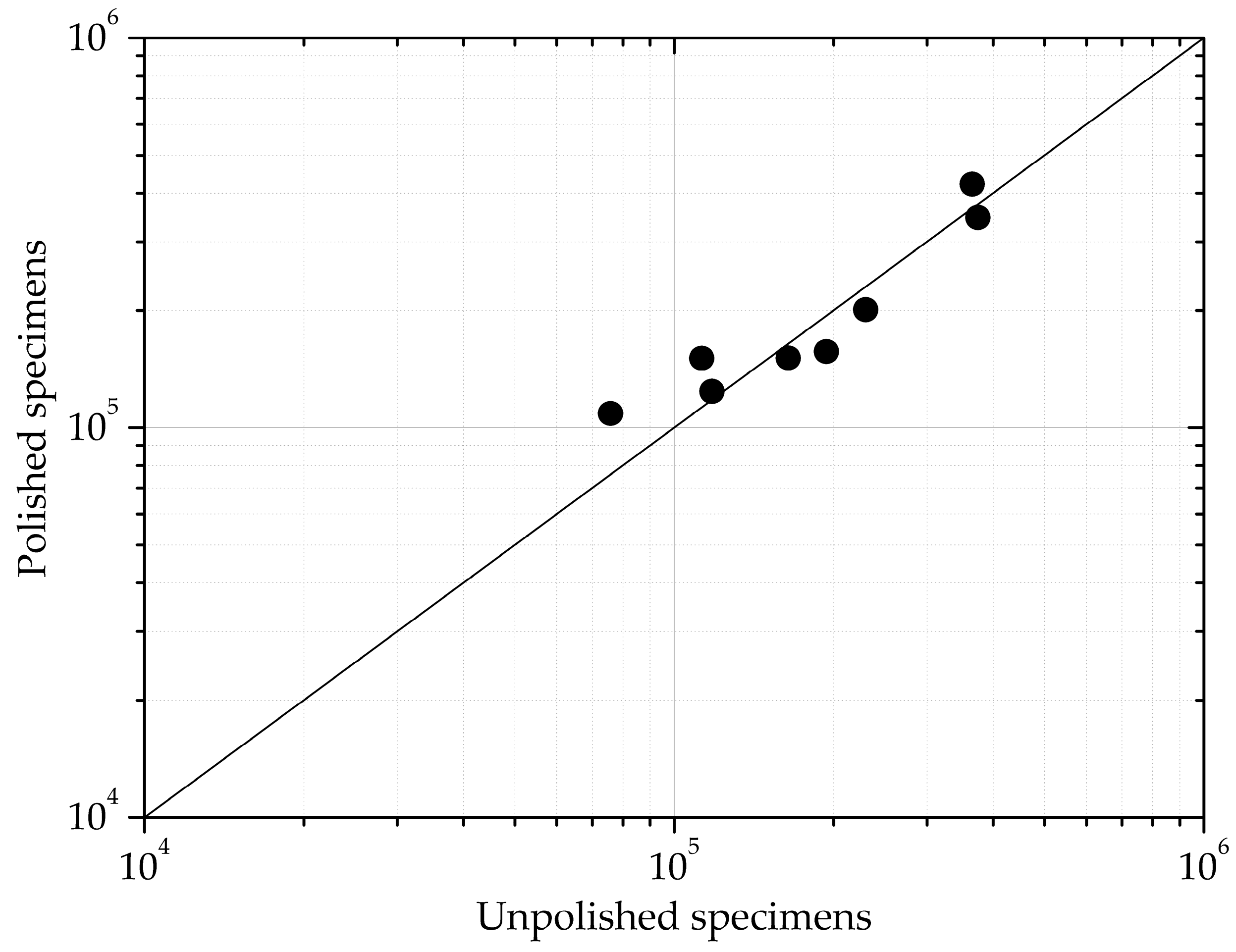
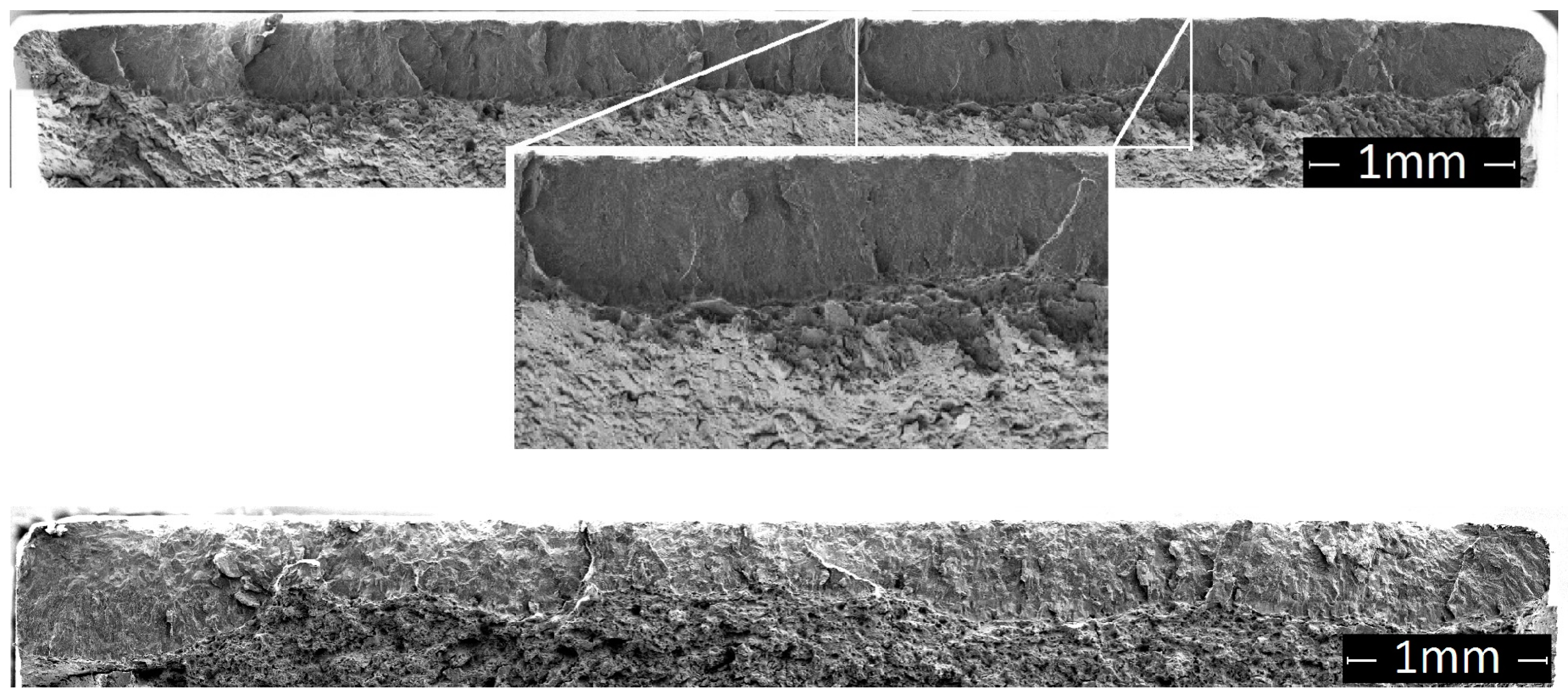



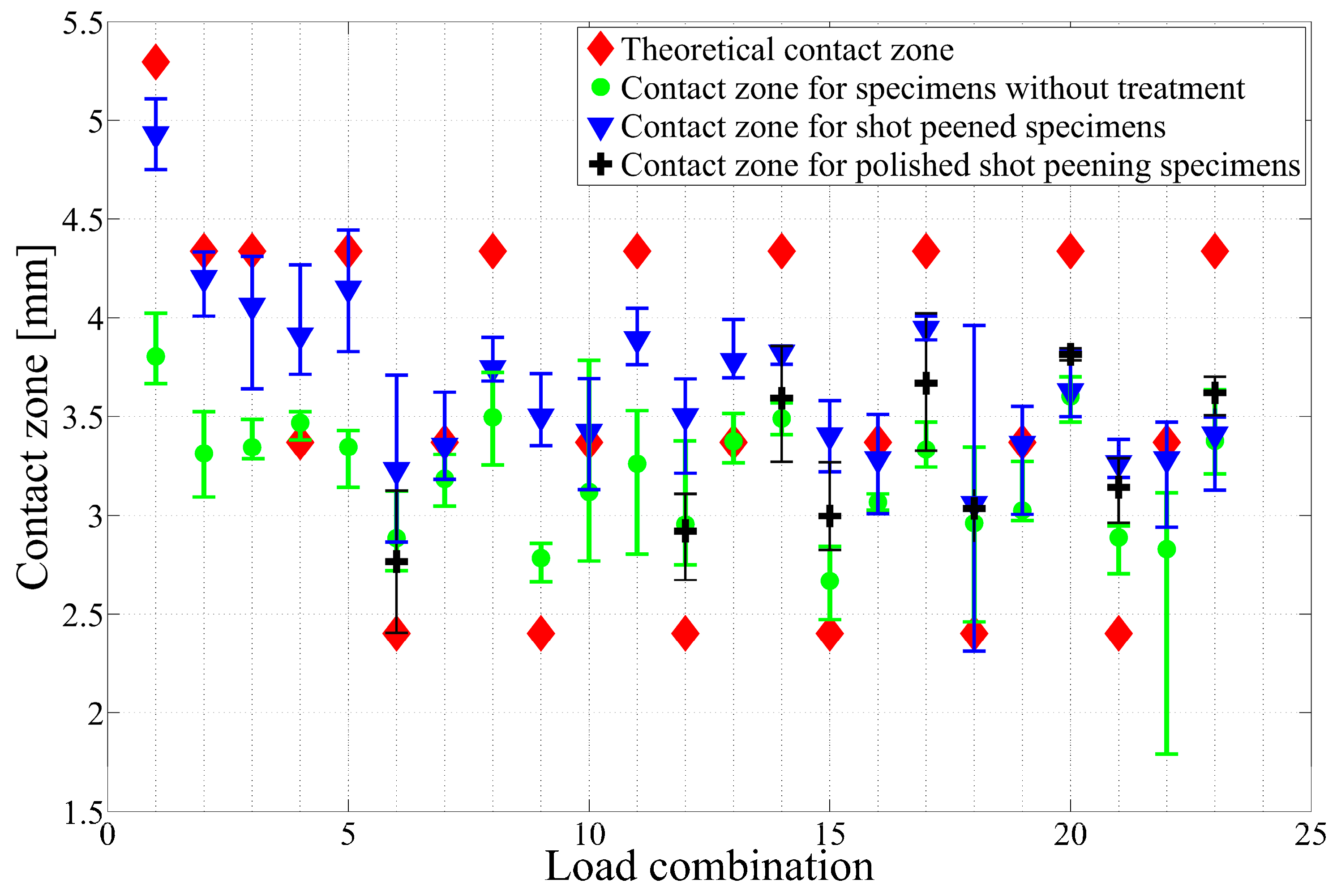
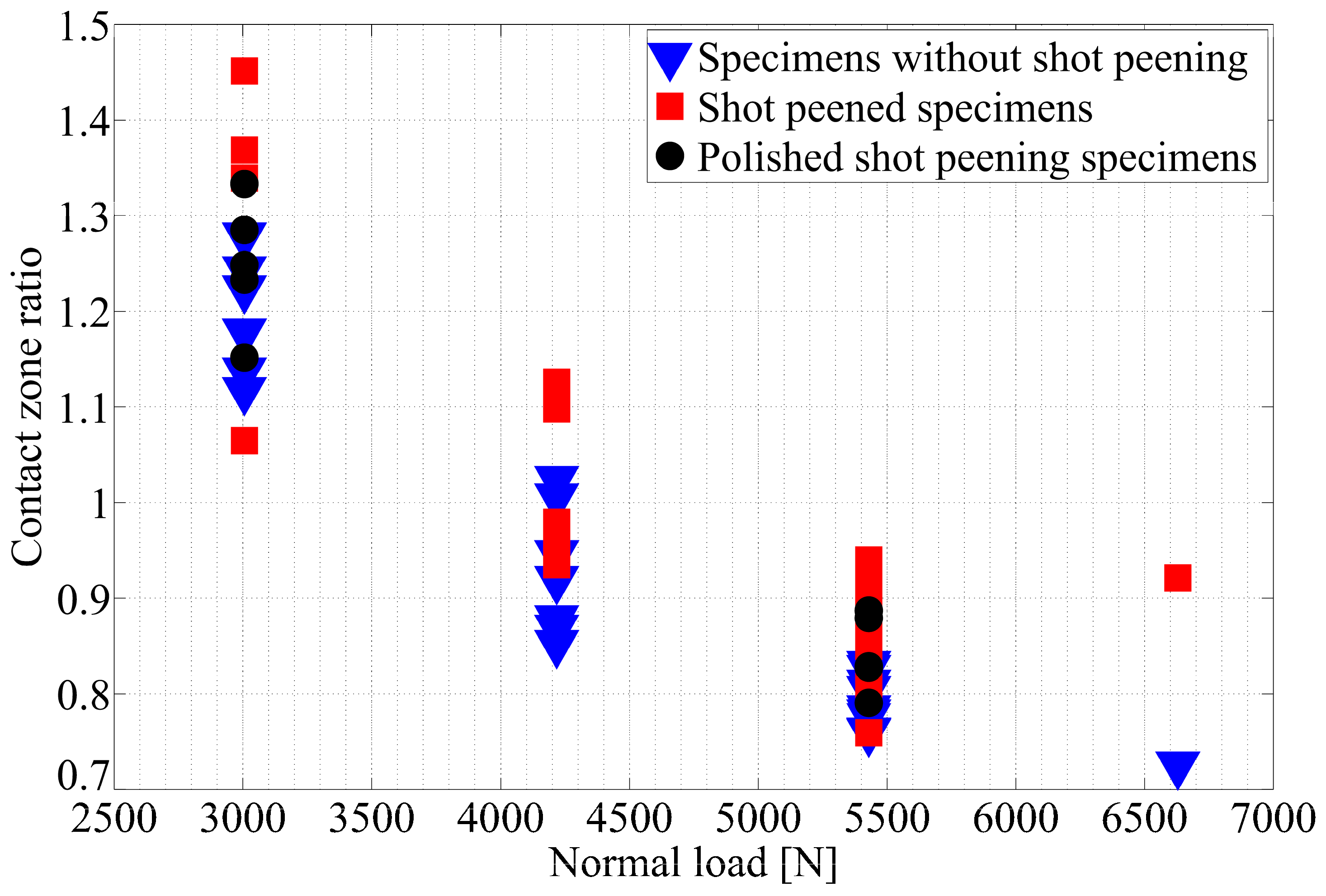
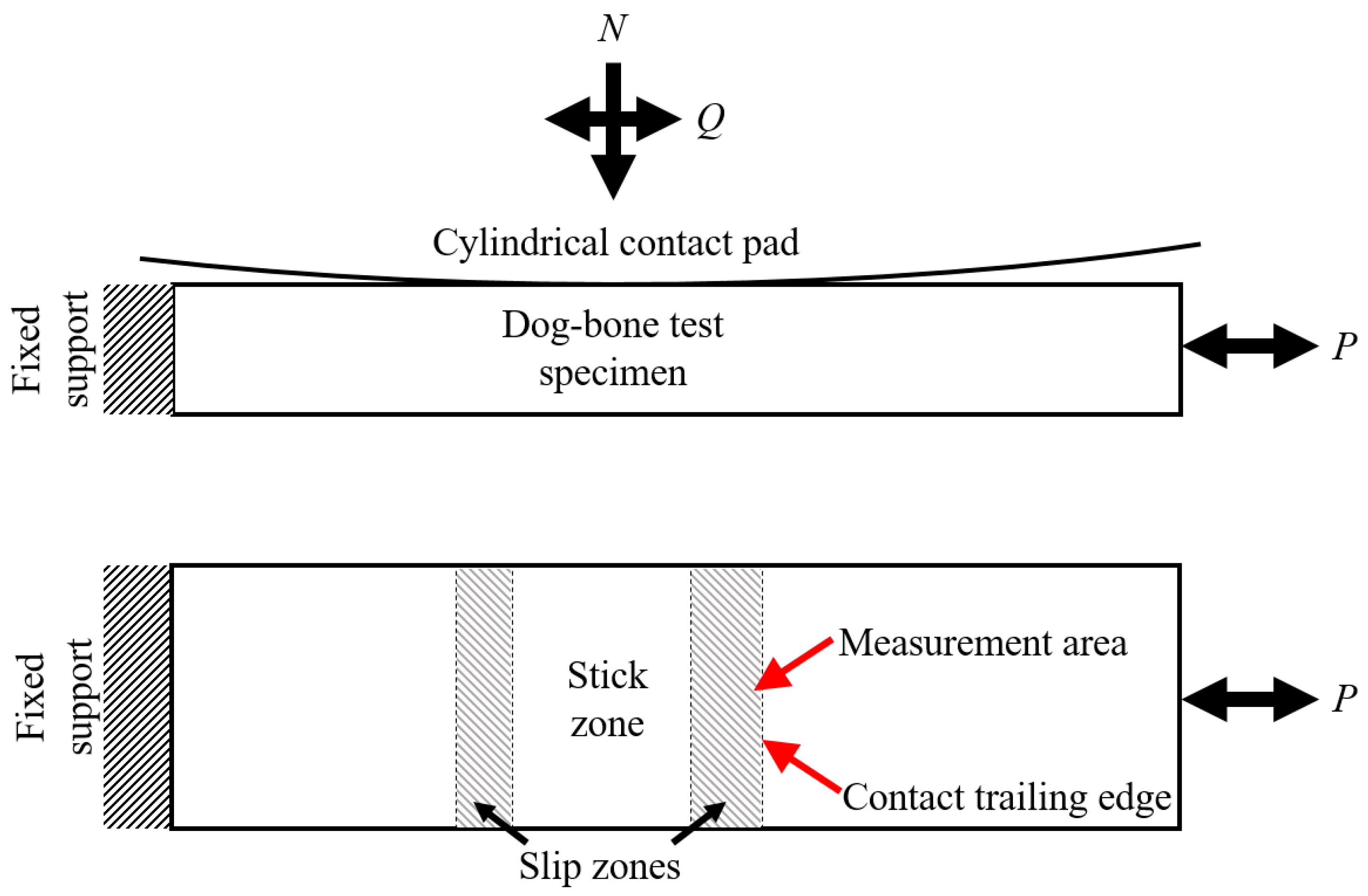
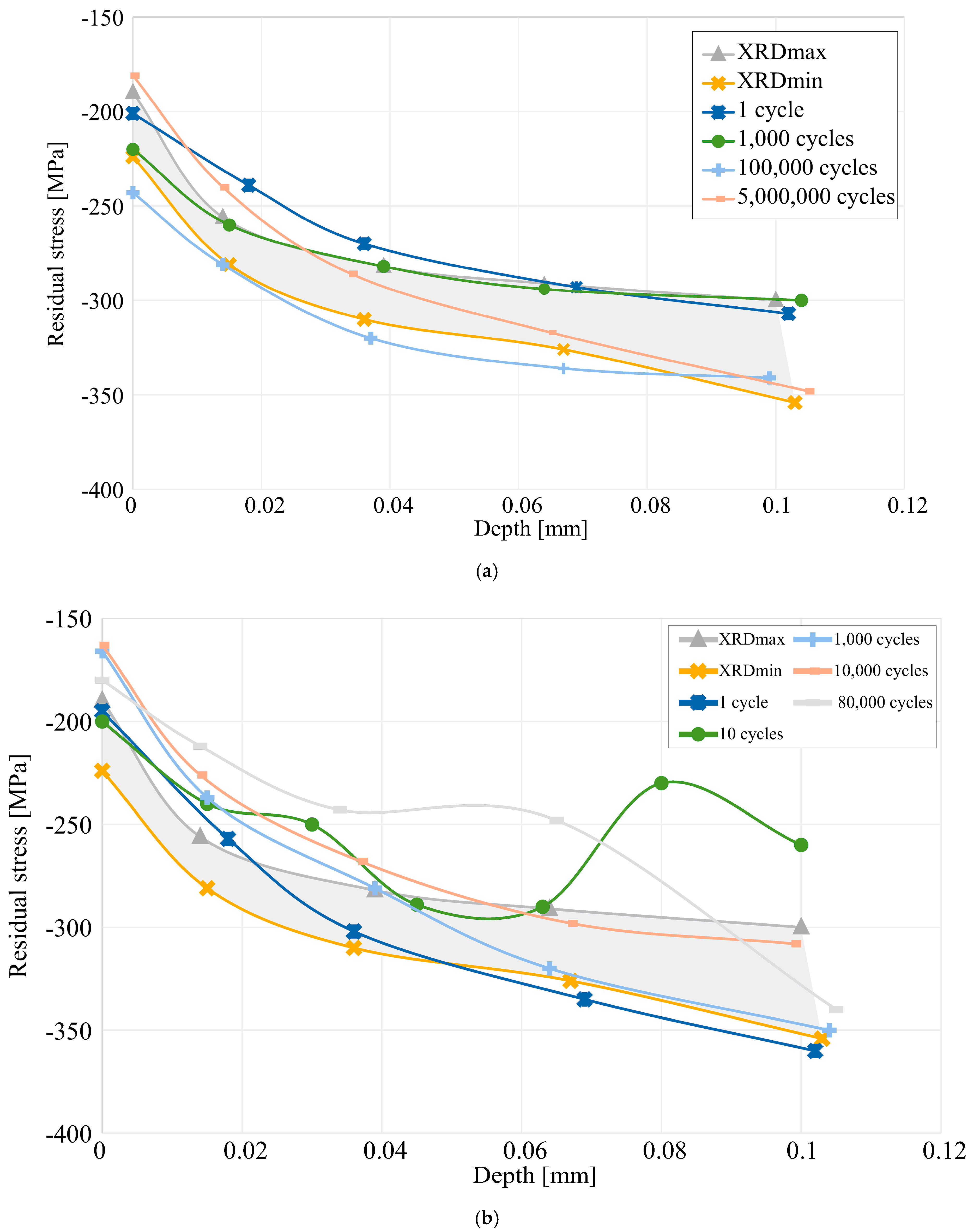
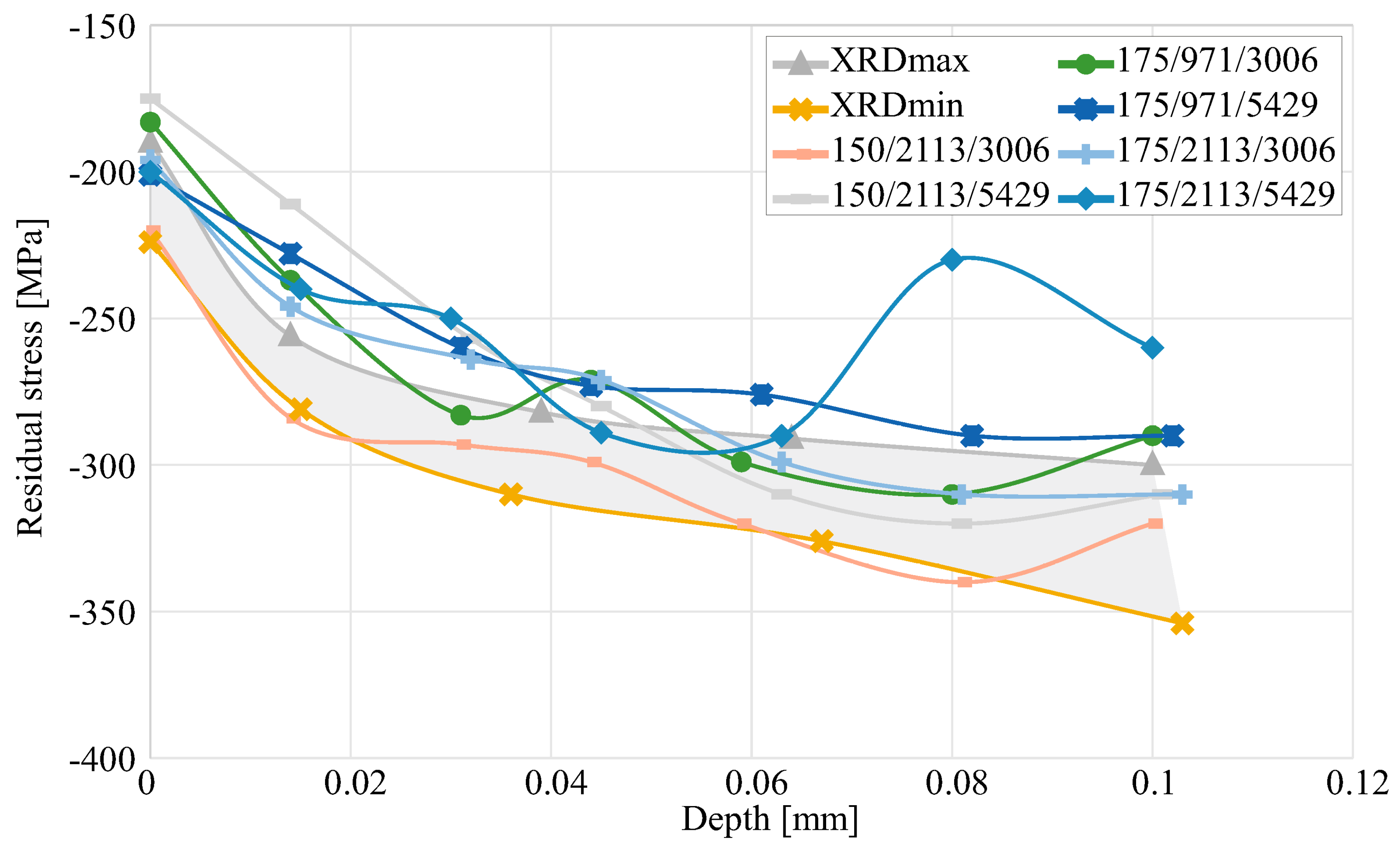
| % | Al | Zn | Mg | Cu | Fe | Si | Mn | Cr | Ti | Others |
|---|---|---|---|---|---|---|---|---|---|---|
| Max | 91.4 | 6.1 | 2.9 | 2.0 | 0.5 | 0.4 | 0.3 | 0.28 | 0.2 | 0.05 |
| Min | 87.1 | 5.1 | 2.1 | 1.2 | - | - | - | 0.18 | - | - |
| Young’s modulus | E | 71 × 103 MPa |
| Poisson’s ratio | ν | 0.33 |
| Yield strength | σy | 503 MPa |
| Tensile strength | σu | 572 MPa |
| Load Num. | σ (MPa) | Q (N) | N (N) | a (mm) | c (mm) | e (mm) | p0 (MPa) | Δσxx (MPa) |
|---|---|---|---|---|---|---|---|---|
| 1 | 70 | 971 | 6629 | 1.63 | 1.47 | 0.11 | 324.1 | 659.3 |
| 2 | 110 | 971 | 5429 | 1.47 | 1.30 | 0.17 | 293.3 | 754.8 |
| 3 | 110 | 1257 | 5429 | 1.47 | 1.24 | 0.17 | 293.3 | 798.2 |
| 4 | 110 | 1543 | 4217 | 1.30 | 0.96 | 0.17 | 258.5 | 822.1 |
| 5 | 110 | 1543 | 5429 | 1.47 | 1.18 | 0.17 | 293.3 | 839.1 |
| 6 | 150 | 971 | 3006 | 1.10 | 0.85 | 0.24 | 218.3 | 805.1 |
| 7 | 150 | 971 | 4217 | 1.30 | 1.10 | 0.24 | 258.5 | 834.0 |
| 8 | 150 | 971 | 5429 | 1.47 | 1.30 | 0.24 | 293.3 | 858.0 |
| 9 | 150 | 1543 | 3006 | 1.10 | 0.66 | 0.24 | 218.3 | 888.3 |
| 10 | 150 | 1543 | 4217 | 1.30 | 0.96 | 0.24 | 258.5 | 914.0 |
| 11 | 150 | 1543 | 5429 | 1.47 | 1.18 | 0.24 | 293.3 | 935.6 |
| 12 | 150 | 2113 | 3006 | 1.10 | 0.38 | 0.24 | 218.3 | 962.9 |
| 13 | 150 | 2113 | 4217 | 1.30 | 0.79 | 0.24 | 258.5 | 986.3 |
| 14 | 150 | 2113 | 5429 | 1.47 | 1.06 | 0.24 | 293.3 | 1006.1 |
| 15 | 175 | 971 | 3006 | 1.10 | 0.85 | 0.27 | 218.3 | 862.2 |
| 16 | 175 | 971 | 4217 | 1.30 | 1.10 | 0.27 | 258.5 | 894.2 |
| 17 | 175 | 971 | 5429 | 1.47 | 1.30 | 0.27 | 293.3 | 920.8 |
| 18 | 175 | 1543 | 3006 | 1.10 | 0.66 | 0.27 | 218.3 | 941.9 |
| 19 | 175 | 1543 | 4217 | 1.30 | 0.96 | 0.27 | 258.5 | 970.8 |
| 20 | 175 | 1543 | 5429 | 1.47 | 1.18 | 0.27 | 293.3 | 994.9 |
| 21 | 175 | 2113 | 3006 | 1.10 | 0.38 | 0.27 | 218.3 | 1013.9 |
| 22 | 175 | 2113 | 4217 | 1.30 | 0.79 | 0.27 | 258.5 | 1040.4 |
| 23 | 175 | 2113 | 5429 | 1.47 | 1.06 | 0.27 | 293.3 | 1062.6 |
| Load Num. | σ (MPa) | Q (N) | N (N) | Nf without S-P | Nf without S-P | Nf with S-P | Nf with S-P |
|---|---|---|---|---|---|---|---|
| 1 | 70 | 971 | 6629 | 316,603 | 165,696 | 5,000,000 † | 5,000,000 † |
| 2 | 110 | 971 | 5429 | 112,165 | 126,496 | 1,811,104 | 980,678 |
| 3 | 110 | 1257 | 5429 | 120,663 | 113,799 | 1,649,736 | 1,941,545 |
| 4 | 110 | 1543 | 4217 | 88,216 | 89,376 | 1,110,174 | 1,117,513 |
| 5 | 110 | 1543 | 5429 | 87,481 | 82,559 | 1,008,310 | 810,402 |
| 6 | 150 | 971 | 3006 | 60,040 | 59,234 | 23,1459 | 665,167 |
| 7 | 150 | 971 | 4217 | 67,776 | 60,288 | 678,676 | 634,259 |
| 8 | 150 | 971 | 5429 | 47,737 | 51,574 | 707,514 | 631,491 |
| 9 | 150 | 1543 | 3006 | 19,223 | 39,408 | 275,417 | 198,884 |
| 10 | 150 | 1543 | 4217 | 50,369 | 39,001 | 234,651 | 497,260 |
| 11 | 150 | 1543 | 5429 | 50,268 | 39,202 | 290,460 | 482,862 |
| 12 | 150 | 2113 | 3006 | 34,904 | 41,002 | 140,189 | 267,873 |
| 13 | 150 | 2113 | 4217 | 34,716 | 40,004 | 166,088 | 201,105 |
| 14 | 150 | 2113 | 5429 | 32,339 | 36,431 | 190,763 | 66,564 |
| 15 | 175 | 971 | 3006 | 26,587 | 31,815 | 364,153 | 366,164 |
| 16 | 175 | 971 | 4217 | 27,724 | 32,843 | 235,467 | 308,455 |
| 17 | 175 | 971 | 5429 | 35,171 | 29,100 | 338,774 | 413,654 |
| 18 | 175 | 1543 | 3006 | 31,224 | 30,154 | 164,835 | 163,474 |
| 19 | 175 | 1543 | 4217 | 34,748 | 34,930 | 169,382 | 164,384 |
| 20 | 175 | 1543 | 5429 | 33,349 | 28,005 | 228,379 | 231,132 |
| 21 | 175 | 2113 | 3006 | 21,669 | 21,207 | 68,801 | 83,544 |
| 22 | 175 | 2113 | 4217 | 26,989 | 28,595 | 121,642 | 127,770 |
| 23 | 175 | 2113 | 5429 | 28,112 | 28,178 | 94,741 | 146,553 |
| Load Num. | σ (MPa) | Q (N) | N (N) | Nf unpolished * | Nf unpolished * | Nf polished | Nf polished |
|---|---|---|---|---|---|---|---|
| 12 | 150 | 2113 | 3006 | 140,189 | 267,873 | 154,964 | 158,621 |
| 14 | 150 | 2113 | 5429 | 190,763 | 66,564 | 147,563 | 153,813 |
| 15 | 175 | 971 | 3006 | 364,153 | 366,164 | 417,318 | 425,643 |
| 17 | 175 | 971 | 5429 | 338,774 | 413,654 | 374,036 | 319,601 |
| 18 | 175 | 1543 | 3006 | 164,835 | 163,474 | 150,578 | 151,347 |
| 20 | 175 | 1543 | 5429 | 228,379 | 231,132 | 233,005 | 173,024 |
| 21 | 175 | 2113 | 3006 | 68,801 | 83,544 | 116,731 | 101,295 |
| 23 | 175 | 2113 | 5429 | 94,741 | 146,553 | 133,132 | 115,329 |
| Samples | Friction Coefficient | Roughness | ||
|---|---|---|---|---|
| Ra (µm) | Ry (µm) | Rz (µm) | ||
| Without shot peening | 0.75 | 0.23 | 1.6 | 1.4 |
| With shot peening—unpolished | 0.85 | 5.59 | 35.21 | 29.23 |
| With shot peening—polished | 0.77 | 0.2 | 3.2 | 2.1 |
| Contact pads | - | 0.13 | 1.53 | 1.13 |
| Load Num. | σ (MPa) | Tangential Force Q (N) | Normal Force N (N) |
|---|---|---|---|
| 12 | 150 | 2113 | 3006 |
| 14 | 150 | 2113 | 5429 |
| 15 | 175 | 971 | 3006 |
| 17 | 175 | 971 | 5429 |
| 21 | 175 | 2113 | 3006 |
| 23 | 175 | 2113 | 5429 |
© 2019 by the authors. Licensee MDPI, Basel, Switzerland. This article is an open access article distributed under the terms and conditions of the Creative Commons Attribution (CC BY) license (http://creativecommons.org/licenses/by/4.0/).
Share and Cite
Martín, V.; Vázquez, J.; Navarro, C.; Domínguez, J. Fretting-Fatigue Analysis of Shot-Peened Al 7075-T651 Test Specimens. Metals 2019, 9, 586. https://doi.org/10.3390/met9050586
Martín V, Vázquez J, Navarro C, Domínguez J. Fretting-Fatigue Analysis of Shot-Peened Al 7075-T651 Test Specimens. Metals. 2019; 9(5):586. https://doi.org/10.3390/met9050586
Chicago/Turabian StyleMartín, Vicente, Jesús Vázquez, Carlos Navarro, and Jaime Domínguez. 2019. "Fretting-Fatigue Analysis of Shot-Peened Al 7075-T651 Test Specimens" Metals 9, no. 5: 586. https://doi.org/10.3390/met9050586
APA StyleMartín, V., Vázquez, J., Navarro, C., & Domínguez, J. (2019). Fretting-Fatigue Analysis of Shot-Peened Al 7075-T651 Test Specimens. Metals, 9(5), 586. https://doi.org/10.3390/met9050586





